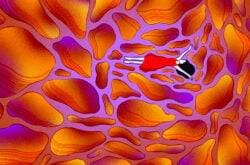Illustration: Nhung Lê
The Aeolian mode is one of the seven common diatonic modes.
Sharing all of the same pitches with the natural minor scale, the Aeolian mode can be used in an incredibly wide range of musical contexts. In this article, let’s discuss what exactly the Aeolian mode is, how it differs from natural minor, some popular tracks that make use of it, and how to apply it to your own music.
Feel free to use the table of contents below to quickly navigate to a specific section.
What you’ll learn:
- What is the Aeolian mode?
- The Aeolian scale formula
- The Aeolian scale in all “keys”
- Songs that use the Aeolian mode
- When to use the Aeolian mode in your music
Let’s get started!
What is the Aeolian mode?
As mentioned above, the Aeolian mode is a mode that shares all of the same pitches as the natural minor scale. If we started on A, then its ascending scale would consist of A, B, C, D, E, F, G, and A.

The A Aeolian scale
The history of the Aeolian mode
The Aeolian mode gets its name from Aeolis, the ancient region consisting of the Aeolian Islands and the adjacent coastal district of Asia Minor where it was believed to have originated. Alongside the other modes, it led to many musical developments in the Medieval and Renaissance periods, where modes started being used as the melodic and harmonic backbone for compositions. Over time, the ideas of modal interplay and modal mixture were also introduced, which encouraged the Aeolian mode to be used alongside other modes in the same composition.
In the 20th century, the Aeolian mode saw a revival through the flourishing of genres such as folk, jazz, and rock, enjoyed for its expressive versatility. Today, it’s used across virtually all styles of music, often to evoke various shades of feelings such as sadness, longing, and melancholy.
The Aeolian scale formula
As you can decipher from the previous example, the Aeolian scale consists of the following intervals:
- Root
- Major second
- Minor third
- Perfect fourth
- Perfect fifth
- Minor sixth
- Minor seventh
If you were to sequence an ascending scale, the intervals could be expressed in shorthand as WHWWHWW (‘whole half whole, whole half whole whole’).
Once you familiarize yourself with this pattern, you can apply it to build an Aeolian scale off of any other root note. For example, here are the notes for a C Aeolian scale using this formula:
- C
- D
- E♭
- F
- G
- A♭
- B♭
- C
If you’re a guitarist, you can refer to the following tablature for a transposable scale:

What’s the difference between the Aeolian mode and natural minor?
With 100% of the notes shared in common, you might be wondering what the difference is between the Aeolian mode and natural minor. The truth is, colloquially they’re often used interchangeably—many will refer to a piece that relies on natural minor as Aeolian, and vice versa.
However, if we want to be precise, the primary distinction is whether functional harmony—and dominance in particular—is emphasized by the music. For example, even if a song is mainly in natural minor, many times you’ll find that the major V chord is borrowed from harmonic minor at one point or another to strengthen the resolution to the i chord. This would indicate a traditionally minor character, whereas in Aeolian, there’s no emphasis on the tension and release of the tonic / dominant relationship—rather, it’s a more seamless exploration of all of the pitches in the mode.
The Aeolian scale in all “keys”
While familiarizing yourself with the sequence of intervals is arguably far more important than memorizing every scale one-by-one, here’s a table outlining the Aeolian scale associated with every root note for easy reference:
| Root | Notes in the Aeolian scale |
| C | C – D – E♭ – F – G – A♭ – B♭ – C |
| C♯ | C♯ – D♯ – E – F♯ – G♯ – A – B – C♯ |
| D♭ | D♭ – E♭ – F♭ – G♭ – A♭ – B♭♭ – C♭ – D♭ |
| D | D – E – F – G – A – B♭ – C – D |
| D♯ | D♯ – E♯ – F♯ – G♯ – A♯ – B – C♯ – D♯ |
| E♭ | E♭ – F – G♭ – A♭ – B♭ – C♭ – D♭ – E♭ |
| E | E – F♯ – G – A – B – C – D – E |
| F | F – G – A♭ – B♭ – C – D♭ – E♭ – F |
| F♯ | F♯ – G♯ – A – B – C♯ – D – E – F♯ |
| G♭ | G♭ – A♭ – B♭♭ – C♭ – D♭ – E♭♭ – F♭ – G♭ |
| G | G – A – B♭ – C – D – E♭ – F – G |
| G♯ | G♯ – A♯ – B – C♯ – D♯ – E – F♯ – G♯ |
| A♭ | A♭ – B♭ – C♭ – D♭ – E♭ – F♭ – G♭ – A♭ |
| A | A – B – C – D – E – F – G – A |
| A♯ | A♯ – B♯ – C♯ – D♯ – E♯ – F♯ – G♯ – A♯ |
| B♭ | B♭ – C – D♭ – E♭ – F – G♭ – A♭ – B♭ |
| B | B – C♯ – D – E – F♯ – G – A – B |
We use the term “key” loosely to refer to these, because again, modes don’t follow the same functional behaviors of traditional major and minor keys, which are a requisite of the term in its strictest definition. Also note that several of these are enharmonically equivalent—for example, the modes built off of G♯ and A♭ share all of the same pitches, but are simply expressed differently in writing.
Songs that use the Aeolian mode
While scales are a necessary starting point, they don’t paint a complete picture of the Aeolian mode’s sound by themselves. Let’s begin to familiarize ourselves with the mode by listening to a few pieces of music from varying genres and contexts that feature its sound, and explore what makes them feel distinctly Aeolian as opposed to minor.
1. “Heartache” by Toby Fox (from UNDERTALE) (2015)
Toby Fox’s “Heartache” from the beloved UNDERTALE soundtrack makes use of the Aeolian mode to achieve an earnest emotional intensity that’s perfect for the conflict it underscores in the game. It starts with a motif that strongly emphasizes the root, B♭, and then progressively adds layers that swell into a cohesive whole. The piece does briefly modulate to a different pitch center before arriving back to B♭, but without using any leading tones or secondary dominance that would break away from the Aeolian feel.
2. “Doomed” by Bring Me The Horizon (2015)
Bring Me The Horizon’s “Doomed” showcases the darker moods the Aeolian mode can achieve. A droning synth strongly grounds us around F♯ right from the jump, and the vocals and various instruments layer over it to achieve different harmonic textures in the verse. The explosive chorus’ use of the minor v chord in addition to the emphasis of the flattened sixth—one of the mode’s characteristic pitches—in the vocal hook also reinforce the Aeolian sound.
3. “lovely (with Khalid)” by Billie Eilish (2018)
Last but not least, we have Billie Eilish and Khalid’s heart-tugging “lovely.” The ♭VI – i – v chord progression outlined by the piano highlights the flattened sixth while also consistently emphasizing the root in the right hand. The swelling vocals and strings create a soupy, melancholy feel that’s also very Aeolian, and as with “Heartache” and “Doomed,” the raised seventh is nowhere to be found.
When to use the Aeolian mode
Arguably the most popular mode, the Aeolian mode is highly versatile and widely applied. Because of this, it’s simply impossible to capture all of its use cases, but below are a few common themes if you’re wondering when and how you should use the mode in your music.
1. Express feelings of melancholy or sadness
As we’ve explored above, the Aeolian mode is overwhelmingly used to express feelings of melancholy or sadness. These emotions can be referenced subtly when paired with upbeat tempos or pivots to Ionian, or you can combine the mode with slower tempos and emotive arrangements like swelling strings for a more devastating effect.
2. Complement lyrical themes
In a similar vein, if your song’s lyrics center around themes like personal struggle, introspection, or heartbreak, the Aeolian mode can provide a harmonic backdrop that creates cohesion between the music and the lyrics, elevating what your words are trying to convey.
3. Bring out the characteristics of other modes
Due to its prevalent nature, the Aeolian mode might not be as immediately ear-catching as the other diatonic modes. If you’re employing modal mixture or modal interplay in your music, you can use its ‘vanilla’ sound to your advantage, juxtaposing the Aeolian mode against the other modes to further emphasize their defining pitches.
Conclusion
While there’s far from just one way to use it, the Aeolian mode provides an iconic color that’s essential to any musician’s toolkit. Hopefully this guide gave you a foundation for how it’s structured, and provided you with some initial ideas for using it that you can apply to create your own unique musical settings.
Do you have any questions around using modes in your music? What other topics in music theory would you like to see us cover next? Start a conversation with us and other music creators via the Splice Discord.
Continue your exploration of modes in music:
July 3, 2023



